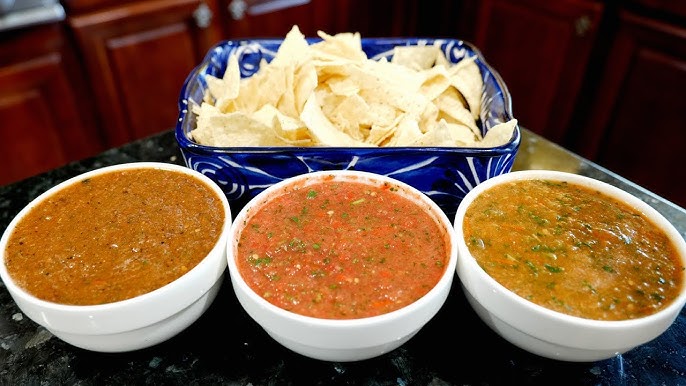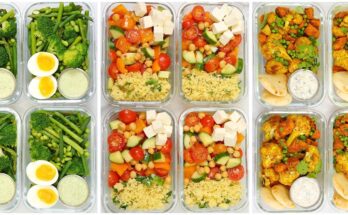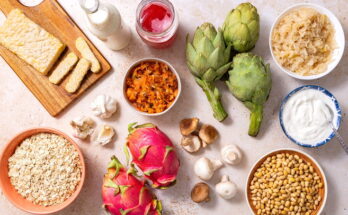Mexican Salsa Recipe: There’s something magical about the flavors of Mexico — bold, vibrant, and endlessly inviting. At the center of it all? Salsa. This isn’t just a side dish; it’s a cultural icon, an essential part of every meal, and a celebration of simple, fresh ingredients transformed into something extraordinary.
Salsa, meaning “sauce” in Spanish, comes in many varieties, each one reflecting different regions and personal tastes. From the smoky richness of a fire-roasted salsa roja to the bright, zingy bite of a salsa verde, Mexican salsa is as diverse as the country itself. Yet no matter the variation, homemade salsa always outshines anything you can buy in a jar. It’s fresher, spicier, and bursting with flavor.
Today, we’re diving deep into the art of making authentic Mexican salsa from scratch. Whether you’re a complete beginner or a seasoned cook looking to level up your skills, this guide will walk you through every step.
Essential Ingredients for Authentic Mexican Salsa
Before we start, let’s talk ingredients. The beauty of Mexican salsa lies in its simplicity — but that means every component counts. Use the best quality you can find to get that authentic, irresistible flavor.
Fresh vs. Canned: Always opt for fresh tomatoes if possible. Canned tomatoes can be convenient but often carry a metallic taste that clashes with the bright, fresh flavors we want in a salsa. Fresh chilies are also preferred, but dried chilies (like guajillo or ancho) can add amazing depth to certain types of salsa.
Key Ingredients:
- Tomatoes: Roma tomatoes are a popular choice because they are meaty and not too watery.
- Chilies: Jalapeños for mild heat, serranos for more spice, or even chipotles for a smoky punch.
- Onion: White onions are standard, but red onions can add a sweet sharpness.
- Cilantro: Fresh cilantro adds that unmistakable herbal note. Skip it if you’re among those who find it tastes soapy.
- Garlic: Fresh cloves, not pre-minced or powdered, to keep the flavor robust.
You can also play around by adding a splash of lime juice, a pinch of sugar, or some cumin for an extra layer of flavor.
Tools You’ll Need
Making salsa is pretty straightforward, but having the right tools can make a huge difference in texture and flavor.
Mortar and Pestle (Molcajete): Traditionally, salsa was made by hand-grinding the ingredients in a molcajete — a large, rough stone mortar and pestle. This method releases the oils and flavors in a way that a blender can’t quite replicate. If you have one, use it!
Blender or Food Processor: If you’re short on time or don’t have a molcajete, a blender or food processor will do just fine. Just be cautious not to overblend — you want your salsa to have some texture, not turn into a smoothie.
Other Useful Tools:
- Sharp knife
- Cutting board
- Skillet or griddle (for roasting)
- Tongs (for turning ingredients as they roast)
Pro tip: If you roast your ingredients, it’s easier to peel the tomatoes and chilies afterward, giving your salsa a smoother texture.
Step-by-Step Guide to Making Mexican Salsa
Now comes the fun part — let’s make some salsa! Follow these steps carefully for the most delicious, authentic results.
Step 1: Selecting the Right Tomatoes
Choosing the right tomato is crucial. Roma tomatoes are perfect because they’re not too watery and have a nice balance of sweetness and acidity. If you can’t find Roma tomatoes, vine-ripened tomatoes are a great substitute.
Look for tomatoes that:
- Are deep red in color
- Feel firm but slightly tender
- Smell fragrant at the stem
Avoid tomatoes that are overly soft or have blemishes, as these can make your salsa taste off.
Quick Tip: If it’s not tomato season, roasting even average tomatoes can deepen their flavor significantly, masking any lack of sweetness.
Step 2: Roasting for Extra Flavor
Roasting is the secret weapon of many great salsa recipes. It brings out the natural sugars in the vegetables, adds a smoky depth, and softens everything beautifully.
How to roast:
- Preheat your skillet, griddle, or oven broiler.
- Place the tomatoes, chilies, garlic cloves (unpeeled), and onion halves on the hot surface.
- Turn occasionally until they are blistered and slightly charred on all sides.
- Remove the garlic early — it will roast faster than the others.
Once everything is roasted, let them cool slightly. Peel the garlic and, if you want a smoother salsa, peel the tomatoes and chilies too.
Note: If you love a deep smoky flavor, leave some of the charred skins on!
Step 3: Blending or Grinding Your Salsa
If you’re using a molcajete, start by grinding the garlic and salt into a paste. Then gradually add chilies, onions, and tomatoes, mashing until you reach your desired consistency.
If you’re using a blender:
- Add the roasted ingredients.
- Pulse a few times — don’t overblend!
- Add fresh cilantro and a squeeze of lime if desired.
- Taste and adjust salt.
Remember: you’re aiming for a chunky salsa, not a puree.
Step 4: Balancing Flavors Perfectly
Taste your salsa before serving — this is your chance to adjust! Here’s how:
- If it’s too spicy, add a roasted tomato or a splash of lime juice.
- If it’s too bland, add a pinch more salt.
- If it’s too acidic, a tiny pinch of sugar can work wonders.
Let your salsa sit for at least 15 minutes before serving. This resting time lets the flavors meld beautifully.
Tips for the Perfect Salsa Every Time
Getting your salsa just right might take a few tries, but with a little practice and these tips, you’ll be impressing everyone at the table!
Adjust the Heat: Everyone’s spice tolerance is different. Start with fewer chilies and add more after tasting. You can also remove the seeds and membranes from the chilies, which hold most of the heat, to make a milder salsa.
Balance the Acidity: Fresh tomatoes have natural acidity, but sometimes you’ll want a splash of lime juice to brighten up the flavor even more. Taste and adjust until it hits that sweet spot of tangy without being sour.
Salt Matters: Don’t underestimate the power of salt. It doesn’t just make your salsa salty — it enhances all the other flavors. Always season gradually and taste as you go.
Storage Tips: Store your salsa in an airtight container in the fridge. It tastes even better after a few hours as the flavors meld together! Homemade salsa can last about 4–5 days refrigerated. If you need it to last longer, you can freeze it, but keep in mind the texture might become a bit watery after thawing.
Pro Tip: Add a touch of olive oil for a richer mouthfeel and a subtle depth of flavor, especially if you’re pairing the salsa with grilled meats.
Common Variations of Mexican Salsa
One of the best things about salsa is how versatile it is. Here are some of the most beloved variations across Mexico:
Salsa Roja (Red Salsa)
This is what most people think of when they hear “salsa.” Made with red tomatoes and red chilies, it can range from mild to fiery hot. Roasting the ingredients gives it a deeper, smokier flavor, while blending them raw keeps it fresher and lighter.
Ingredients:
- Roasted or raw tomatoes
- Red chilies (like serrano or jalapeño)
- Onion
- Garlic
- Cilantro
- Salt
Perfect with tacos, nachos, and grilled meats.
Salsa Verde (Green Salsa)
Salsa verde gets its vibrant color and tangy flavor from tomatillos, which look like small green tomatoes wrapped in husks. It’s usually a bit more tart than salsa roja.
Ingredients:
- Tomatillos
- Green chilies (serrano or jalapeño)
- Onion
- Garlic
- Cilantro
- Lime juice
- Salt
Great for spooning over enchiladas, tacos, or just about anything!
Pico de Gallo (Fresh Chunky Salsa)
Pico de gallo is more of a salad than a sauce. It’s a chunky mix of diced raw tomatoes, onions, chilies, and cilantro, often seasoned with lime juice and salt. It’s ultra-fresh, crunchy, and perfect for scooping up with tortilla chips.
Ingredients:
- Fresh diced tomatoes
- Chopped onions
- Chopped cilantro
- Minced chilies
- Fresh lime juice
- Salt
Ideal for tacos, burritos, or simply as a fresh side dish.
Serving Ideas for Mexican Salsa
You made a killer salsa — now how should you serve it? The possibilities are endless! Here are some of the best ways to enjoy it:
- Tortilla Chips: The classic combo. Perfect for parties, game days, or just a lazy afternoon snack.
- Tacos: A spoonful of fresh salsa can elevate even the simplest taco to gourmet levels. Whether it’s carne asada, carnitas, or a veggie taco, salsa is a must.
- Grilled Meats: Salsa adds a bright, juicy contrast to smoky grilled beef, chicken, or pork.
- Eggs: Try drizzling salsa over scrambled eggs or an omelet for a zesty breakfast treat.
- Rice and Beans: Mix a bit of salsa into your rice or beans to add a burst of flavor without needing extra seasoning.
- Soups and Stews: A dollop of salsa can brighten up hearty soups like tortilla soup or black bean stew.
Get creative — once you start adding salsa to your meals, you’ll wonder how you ever lived without it!
FAQs about Mexican Salsa Recipe
What is the secret to a good Mexican salsa?
The secret lies in using fresh ingredients like ripe tomatoes, spicy chilies, and fragrant cilantro. Roasting or charring the vegetables can also deepen the flavors and give your salsa that authentic Mexican taste.
Can I make Mexican salsa ahead of time?
Yes! Salsa actually tastes better when it sits for a few hours or overnight. It allows the flavors to meld beautifully. Just store it in an airtight container in the refrigerator.
Is it better to use fresh or canned tomatoes for salsa?
Fresh tomatoes are best for a vibrant, flavorful salsa. However, if tomatoes are out of season, good-quality canned tomatoes can still produce a delicious salsa.
How long does homemade Mexican salsa last?
When properly stored in the fridge, homemade salsa can last for up to 5 days. Always check for any changes in smell or appearance before consuming.
Can I freeze Mexican salsa?
Absolutely! You can freeze salsa for up to 2 months. Just note that the texture may change slightly when thawed, becoming a bit more watery.
How can I make my salsa spicier or milder?
To make it spicier, add more hot peppers like jalapeños or serranos. To make it milder, remove the seeds and membranes from the peppers or use milder chilies like poblano.
Conclusion
There’s a reason salsa is such a beloved staple of Mexican cuisine. It’s vibrant, fresh, and endlessly customizable. Making it at home might seem intimidating at first, but once you go through the simple steps — roasting, blending, seasoning — you’ll realize it’s one of the easiest ways to bring a taste of Mexico into your kitchen.
The key to great salsa is using fresh ingredients, balancing your flavors carefully, and not being afraid to tweak the recipe to suit your tastes. Whether you prefer a smoky salsa roja, a tangy salsa verde, or a bright pico de gallo, you now have all the tools to make the perfect homemade salsa.
So grab those tomatoes, fire up the skillet, and let’s get salsa-ing!



